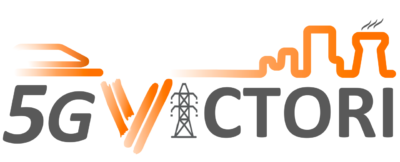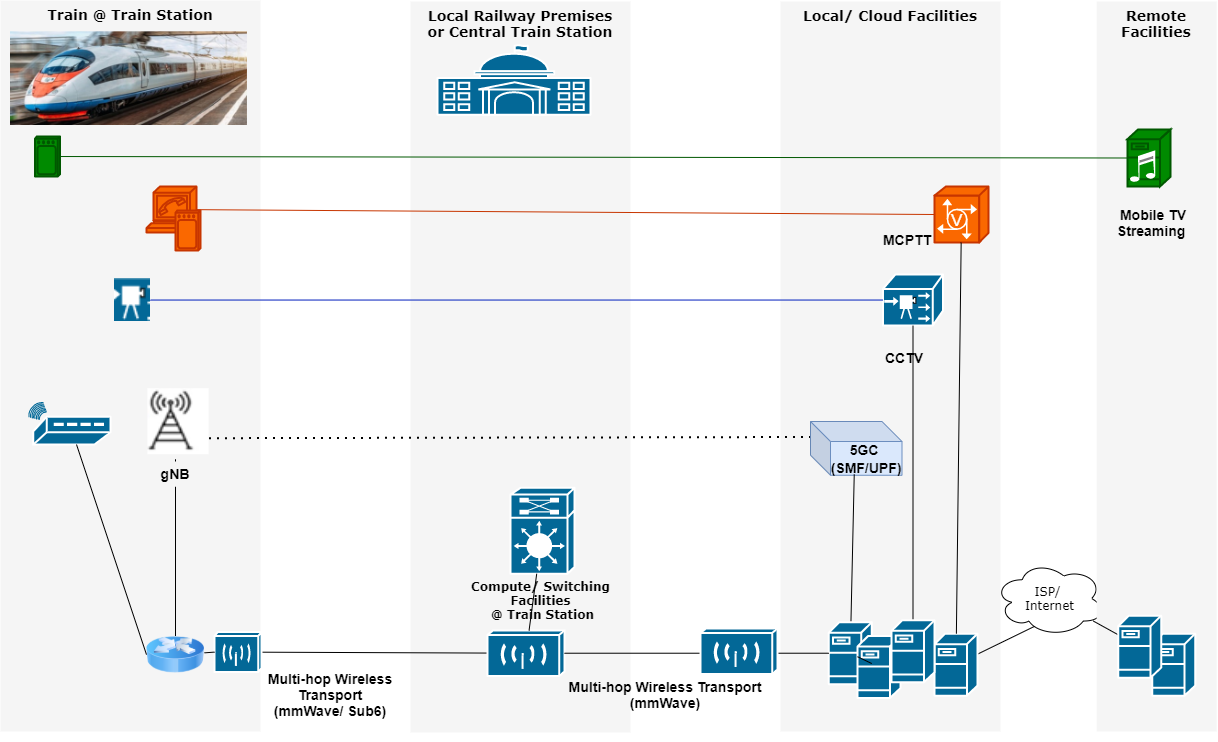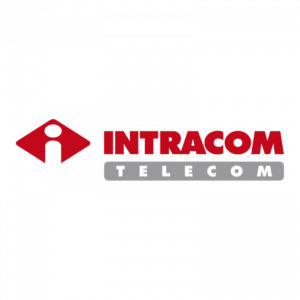The 5G-VICTORI consortium concluded on June 27th in Patras, Greece, its ultimate Field Trials and, as the last event of...
UC #1.1: Enhanced Mobile Broadband under High Speed Mobility
UC #1.1 proposes a multi-technology infrastructure to provide connectivity to a train as it moves along a railway track. Three to four points along the tracks around the city of Patras were chosen to guarantee the coverage required to ensure seamless connectivity for the demonstrated services. The target distance was more than 1 km for a back and forth rail journey. This part of the track was chosen in order to ensure connectivity to the main 5G-VINNI infrastructure at the University of Patras (UoP) premises. On the other hand, this connection requires LoS for the backhaul network from UoP to the track. Additionally, LoS is mandatory to ensure strict alignment for the track to train connectivity.
The services will be provided while the moving train crosses the Patras city center, through heterogeneous technologies, establishing high capacity low latency connections. High capacity is needed for the former services, to provide high quality of service to passengers, whereas for the latter low latency / ultra-reliable connections are needed support the transmission of real time data obtained from various sources to the train operations, driver and control center.
5G-VICTORI Patras Facility
The baseline implementation of the Patras 5G-VICTORI experimental platform is being developed within the ICT-17 5G-VINNI project. The plan in 5G-VICTORI is to upgrade this platform with additional functionalities and to extend it towards several operational facilities owned by Greek vertical industries. This will allow the implementation of the 5G-VICTORI UCs running in Patras, and will be able to also support cross-vertical and cross-facility experimentation and KPIs validation. In this regard, different 5G service classes will be supported, i.e. eMBB, uRLLC and mMTC.
Developed solution
The train moves along the rail track whose stanchions feature various wireless technologies (either Sub-6 or mmWave nodes). The exact number of units depends on the directionality of the antennas and will be defined after the lab testing. The proposed deployment comprises mmWave units and Sub-6 track-side APs (provided by UTH).
At the train side, to maximize connectivity and minimize the disconnection times between handovers from the train to the track APs, the proposed scheme requires antenna modules to be installed both at the front and at the rear of the train. Hence the train incorporates two Sub-6 nodes and two mmWave nodes at the train roof.
This use case differentiates from the prior demonstrated setup in previous 5G-PPP actions through the following contributions on the network side:
- On-board network connectivity is provided jointly from a disaggregated 5G cell and a Wi-Fi Access Point. The new network elements pose different requirements and limitations for the transport network that is backhauling the elements to the core cloud.
- The 5G-VICTORI track-to-train communication is using a heterogeneous wireless network, consisting of sub-6GHz technologies, through IEEE 802.11ax devices, and V-Band 60 GHz mmWave links. The resource heterogeneity will assist in exploring the diversity that accessing different spectrum provides, allowing the setup of robust track-to-train communication links.
- Handover management for train and the heterogeneous track-to-train links is realized using the P4 programming abstractions. P4-based switching allows the programmable configuration of the flows in the network, regardless of the technology that is connecting the train at any time point. Moreover, through the deployment of telemetry tools, managed directly from the network controller managing the different sides of the communication (train and cloud), the handovers can take place in a seamless manner and without replicating traffic over different links. The 5G-PICTURE equivalent used an FPGA based implementation for switching (FlowBlaze [26]) and was replicating traffic over different links that was restricting the scalability of the system.
Service Deployment
The infrastructure will provide three types of services: “Business services” such as infotainment, digital mobility, travel information services, etc. A customised solution of COSMOTE Mobile TV over Internet will be used for the demonstrating the context of this UC; “Performance services”, including non-critical services related to train operation, including infrastructure monitoring and maintenance services. CCTV – assisted supervision of the rail tracks health and maintenance provisioning is the main performance services to be tested. Cameras mounted on the train are capturing images/video of the tracks, viewed in real time at an emulated Railway Operations/Monitoring Centre – or peer viewer; and “Critical services”, where Mission-Critical Push-to-Talk (MCPTT) and Mission Critical Data (e.g. between the controller(s) at the train/ operations centre and the driver/ on-board staff, etc.) are used as indicative applications of this type in the context of this UC.
Related content
-
5G-VICTORI UC #3 in Berlin
Track-to-train communication
-
5G-PICTURE Railway demonstration
Showcased on November 13th 2019 in Barcelona
Related news
Field Trials and Workshop in Greece mark the final milestone for the 5G-VICTORI Project
The 5G-VICTORI consortium will gather in Patras and Athens from Monday, June 26th, to Wednesday, June 28th, to conduct their...
Enhanced Mobile Broadband under High Speed Mobility
The 5G-VICTORI use case “Enhanced Mobile Broadband (eMBB) under High Speed Mobility” will extend the capabilities of the Patras 5G-VINNI...










